The Case of the Cheaper Dinner That Costs More
Walmart says Thanksgiving dinner is 25% cheaper this year. Sounds like great news, right? But there’s a catch. They quietly changed what’s in the meal.
You’re reading Monday Morning Economist, a free weekly newsletter that explores the economics behind pop culture and current events. Each issue reaches thousands of readers who want to understand the world a little differently. If you enjoy this post, you can support the newsletter by sharing it or by becoming a paid subscriber to help it grow:
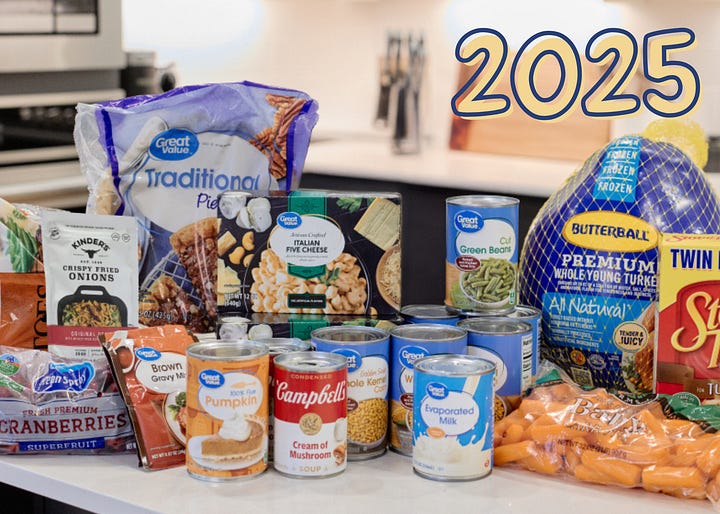
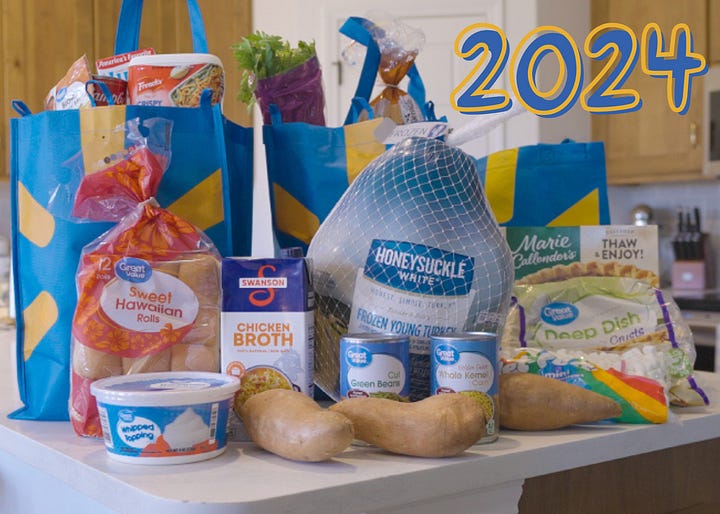
Thanksgiving is supposed to be a time to gather, to carve a turkey, and to forget about how much groceries cost. After two years of food prices rising faster than family paychecks, this year’s holiday meal was shaping up to be another budget-buster.
Then Walmart swooped in with some good news.
The company announced a full Thanksgiving dinner that serves ten people for under $4 per person. That would make it about 25% cheaper than last year! For those of us feeling the sting of inflation at the checkout, that news came as a small miracle. Is it possible that the cost of living was easing just in time for the holidays?
Walmart was hoping shoppers would be thankful and not notice how they pulled off such a big cut. But within hours of the announcement, the internet did what the internet does: it checked the math.
It turns out that the 2025 Thanksgiving Bundle looks pretty different. Last year’s meal included nearly 30 items: stuffing, sweet potatoes, two pies, and all the trimmings. This year’s version? Roughly 15 to 20 items. One pie. Fewer sides. Smaller portions.
Cheaper, yes. But also… less dinner.
And just like that, everyone on social media became a little bit of an economist.
What’s Really Going On Here
Walmart’s Thanksgiving meal didn’t get cheaper because food prices fell. We’ve been living through several years of food inflation, not deflation. The Thanksgiving bundle got cheaper because Walmart changed what went in the cart.
In economic terms, they swapped out the basket. In marketing terms, it’s a clever bit of shrinkflation: a smaller serving dressed up as a savings.
So I decided to check.
I went back to Walmart’s 2024 Thanksgiving bundle, pulled up every item on their website, and repriced those same products using the current prices listed there. No coupons, no limited-time deals. The result: about $7.38 per person.
Last year, Walmart claimed its bundle served eight people for “less than $7 per person.” Let’s be generous and assume it costs $6.99 per person. That means the price of the same basket increased by 5.6% since this time last year. That’s close to double the most recent grocery inflation rate reported by the Bureau of Labor Statistics.
And here’s a fun twist: Walmart announced a lower price in 2024 as well, but they had a footnote explaining that their “lower price” was based on comparable items from the previous year. A similar footnote is missing in the 2025 version.
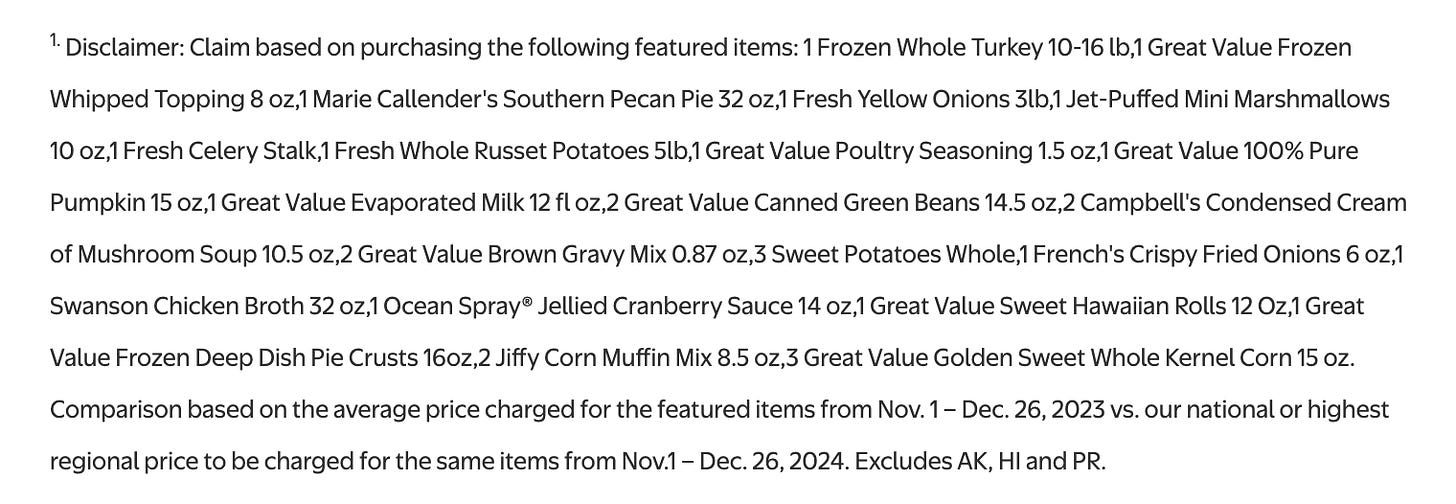
The Real Economics Behind the Basket
Right now, people online are busy comparing this year’s Thanksgiving dinner to last year’s. And that’s exactly the kind of thinking economists use when they measure inflation.
The Bureau of Labor Statistics (BLS) does the same thing, just on a much bigger scale. Instead of cranberry sauce and green beans, they track the cost of a massive basket of goods and services that represent how Americans actually live. It includes everything from groceries and rent to movie tickets, clothing, medical care, and gas.
That’s the idea behind the Consumer Price Index, or CPI: keep the basket as consistent as possible so price changes reflect inflation, not substitutions.
And that basket? It’s enormous. The BLS doesn’t just separate food at home (groceries) from food away from home (restaurants and fast food). It breaks those down further into categories like cereals and bakery products, meats, poultry, fish, and eggs, dairy, fruits and vegetables, and beverages. Even those categories get divided again if you really want to get wonky.
Each item also carries a weight, depending on how much households spend on it. Rent, for instance, counts for more than milk because it takes up a bigger share of a family’s budget. Those spending weights used to be updated only once every decade, but now they’re refreshed every year, using data from two years earlier.
So while we’re casually comparing the cost of Thanksgiving sides, there’s an entire team at the BLS spending months tracking prices for the same products, in the same sizes, from the same stores, all to make sure the comparison from one year to the next actually means something.
Which brings us back to Walmart. Walmart didn’t keep the basket constant. They swapped out French’s Crispy Fried Onions (6 oz) for Kinder’s Fried Onions (4.5 oz). They dropped a pie, nixed the sweet potato casserole, and added a bag of baby carrots and some store-brand mac and cheese.
It’s like rewriting the CPI basket every year to make the math look better. If the BLS did that, inflation would vanish overnight. Rent too high? Take it out. Beef prices up? Replace it with chicken. Inflation: solved.
Of course, that wouldn’t actually make life any cheaper. It would just mean we stopped measuring the same thing.
Final Thoughts
Here’s the funny thing: the internet caught this one fast. Within hours of Walmart’s announcement, people were already pointing out that the cheaper dinner came with fewer sides and smaller portions. And that’s actually encouraging. It means we’re all wired to think like economists, at least a little.
Because in real life, our own baskets are always changing. When eggs get pricey, we make oatmeal. When gas prices go up, we drive less. Economists call that the substitution effect, and it’s a natural part of how we respond to rising prices. It’s also why the official inflation rate can feel different from your own experience. Your basket changes faster than the Bureau of Labor Statistics’ does.
The BLS updates its basket slowly and carefully, reflecting how Americans spend their money over years, not weeks. Walmart, on the other hand, probably decided to swap a pie for carrots and mac and cheese solely to make the price tag look better. It’s clever marketing, not careful measurement.
If you catch any friends or family posting about Walmart’s “cheaper” Thanksgiving dinner, help them think like economists. Drop this article in the comments, or share the link as a friendly reply the next time someone celebrates prices “finally coming down.”
Consumers who stick to store brands are expected to spend a total of about $80 on Thanksgiving dinner ingredients for a meal to feed 10 people, while buying brand-name products could push that amount to $95 [CBS News]
The 12-month inflation rate for “food at home” was recorded at 2.7% for September 2025 [Bureau of Labor Statistics]
According to the National Turkey Federation, Americans consume around 46 million turkeys, or about 1.4 billion pounds of turkey, during the Thanksgiving holiday [American Farm Bureau]
Aldi is advertising a Thanksgiving meal for ten people at $40, the same price as Walmart’s 2025 bundle [Aldi]



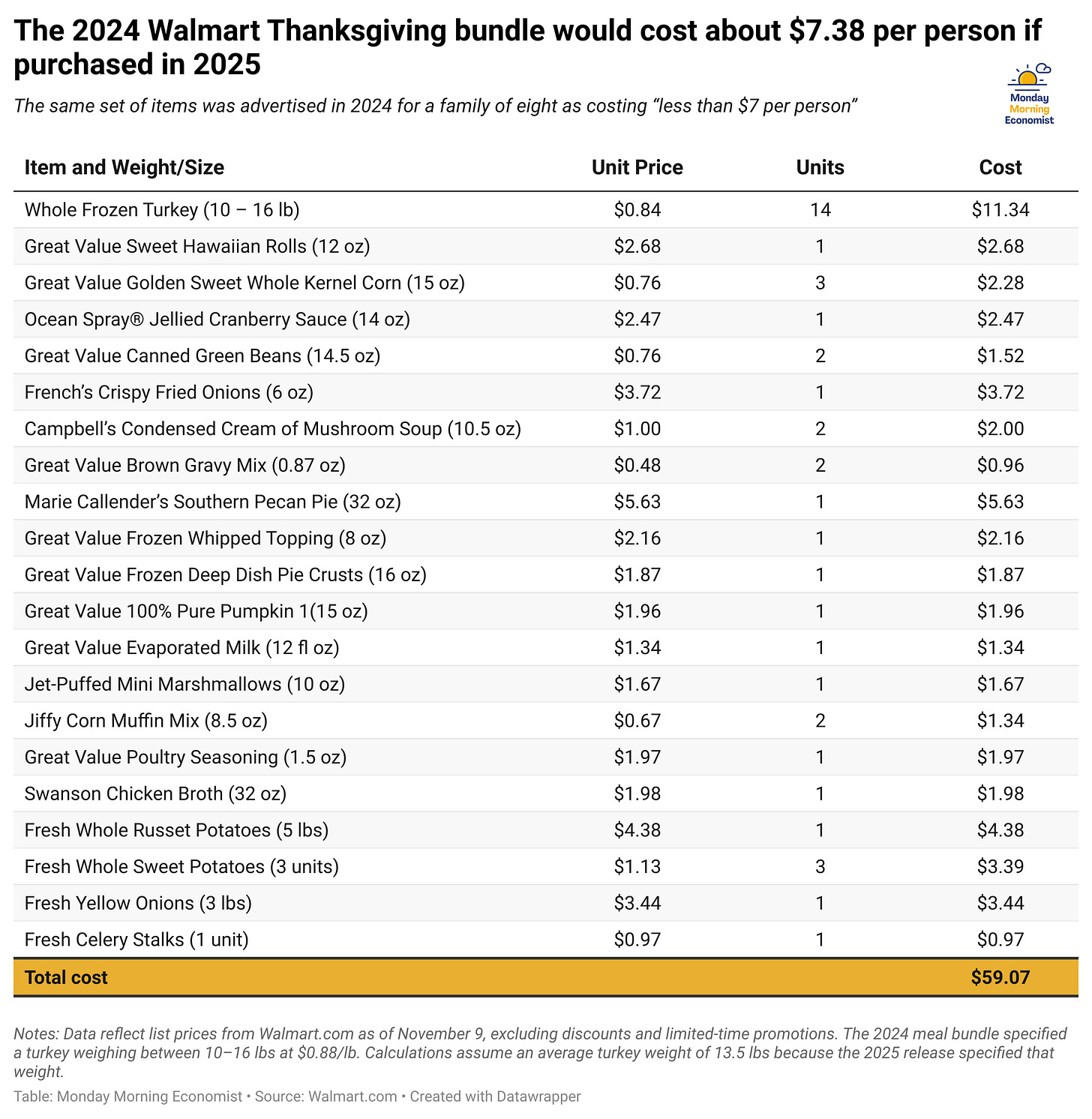
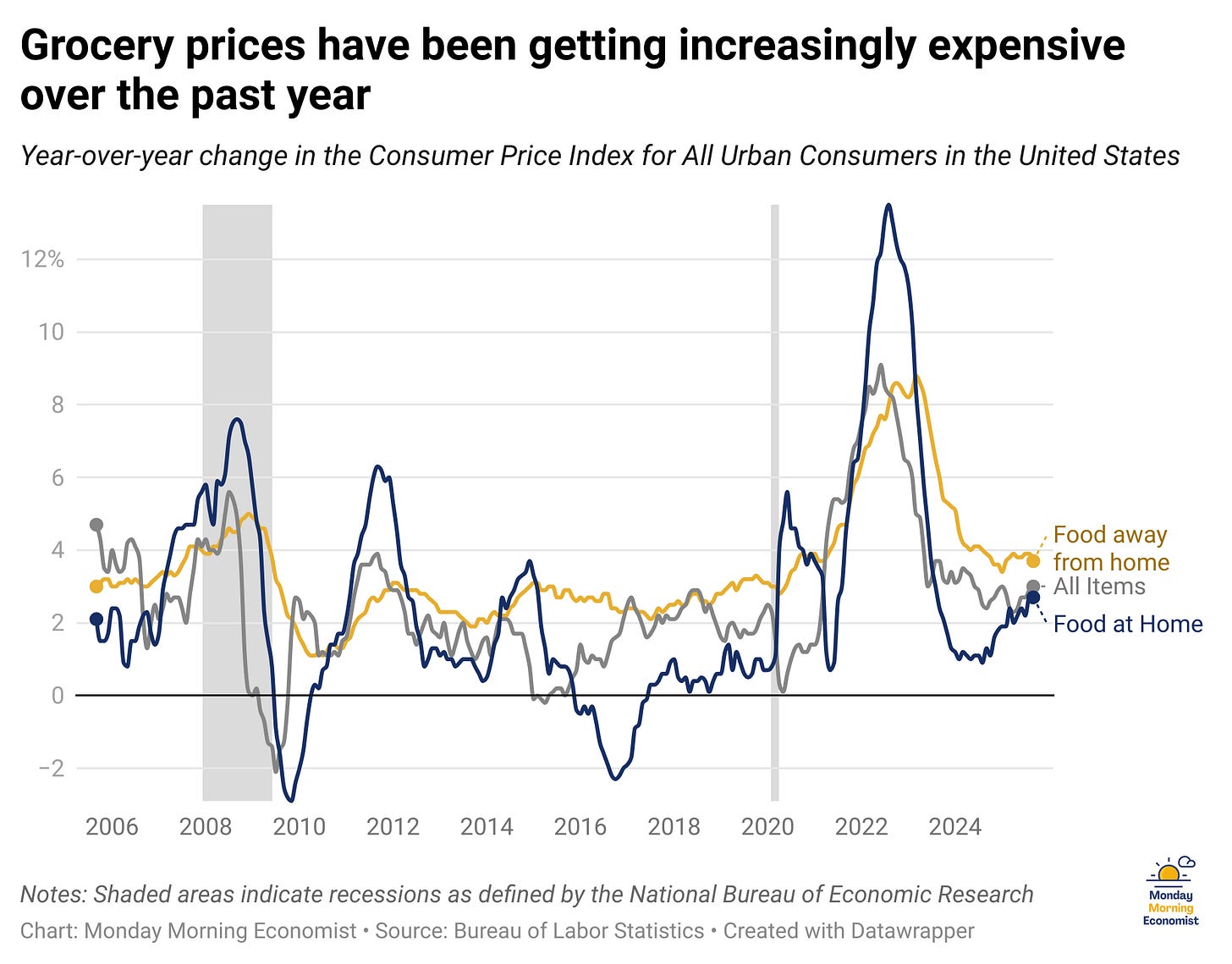
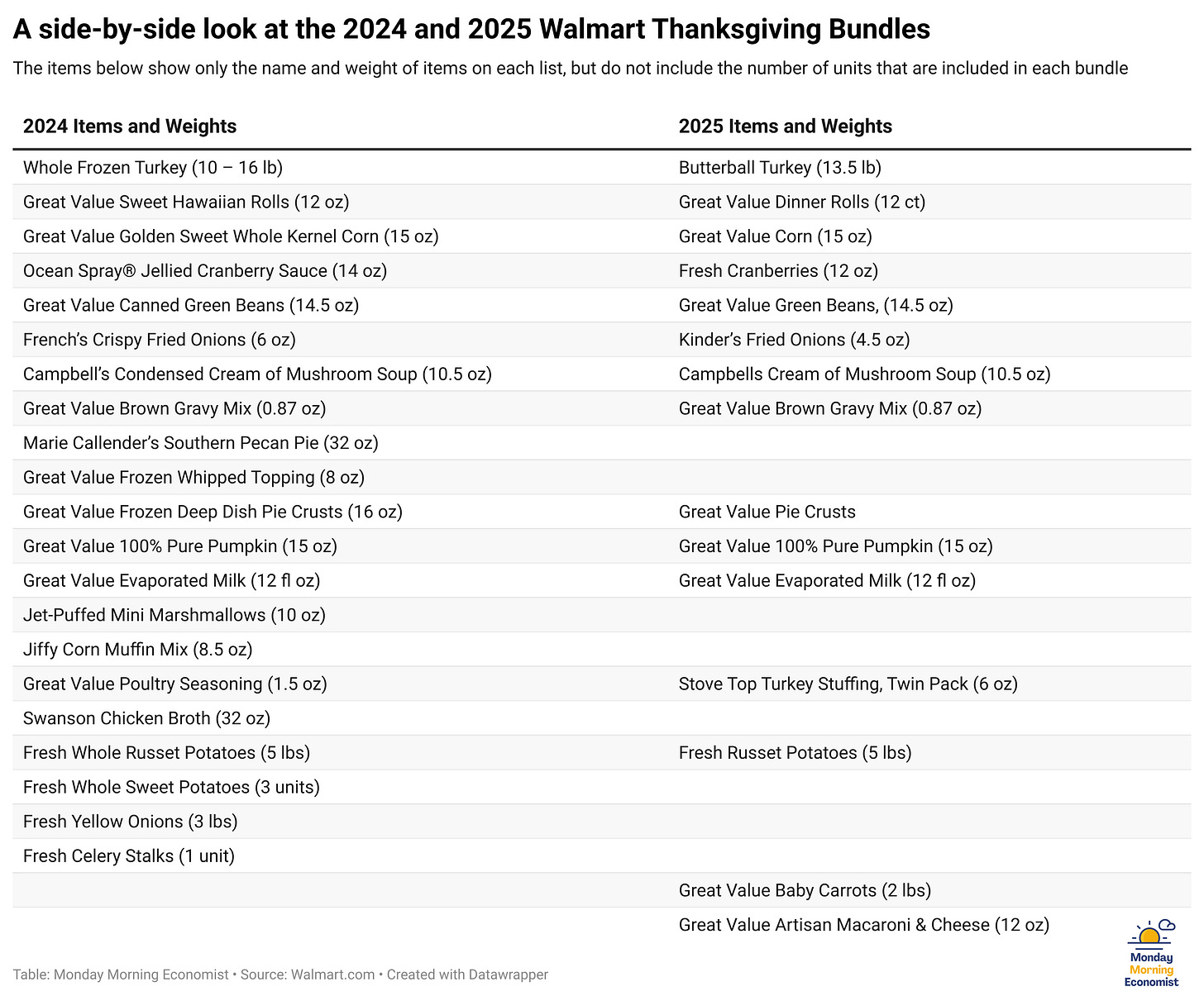

Perhaps crowd-sourcing this kind of data would be a useful alternative as government data becomes more scarce.
Perfect timing! I'm teaching inflation this week.